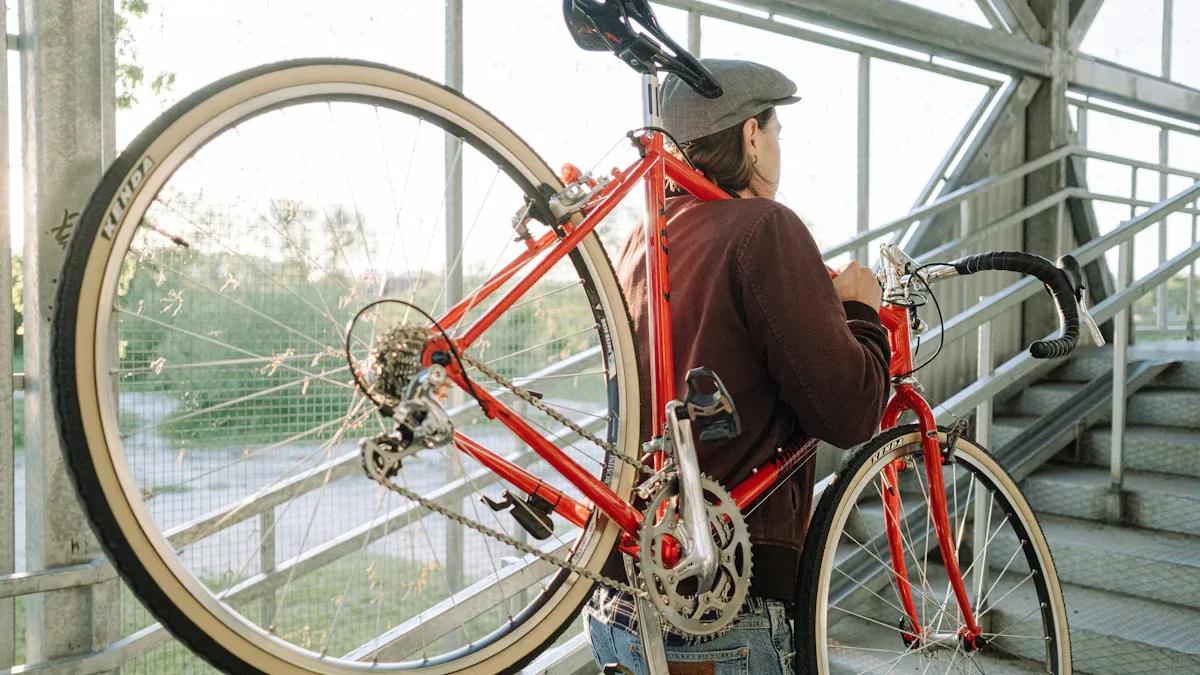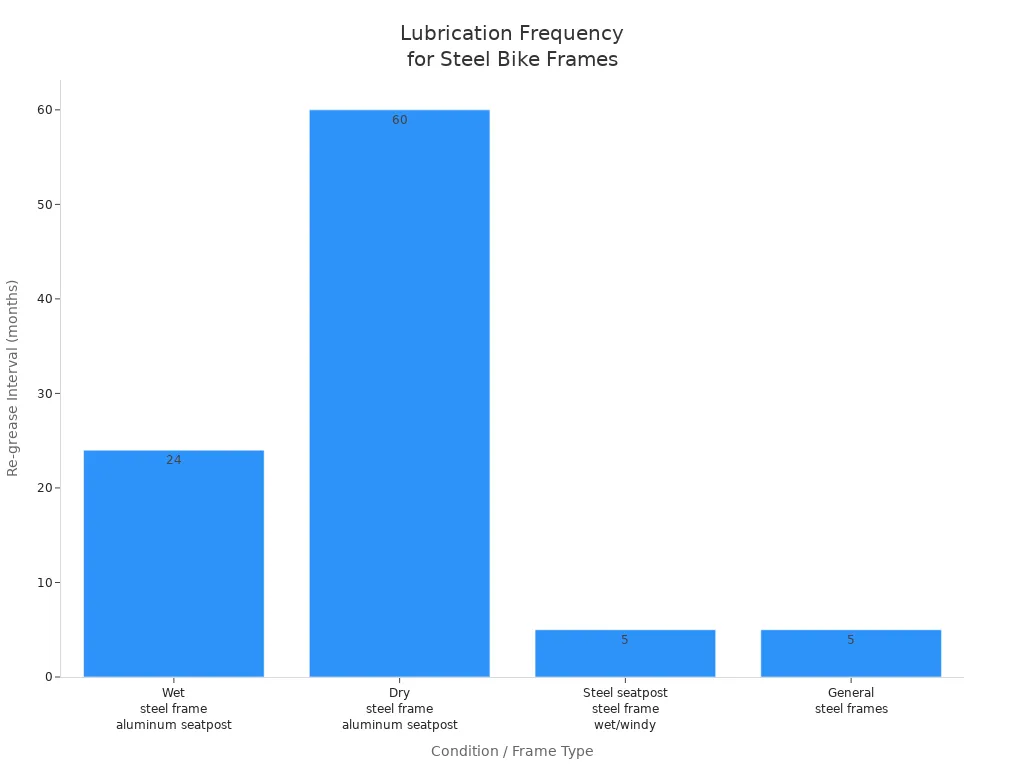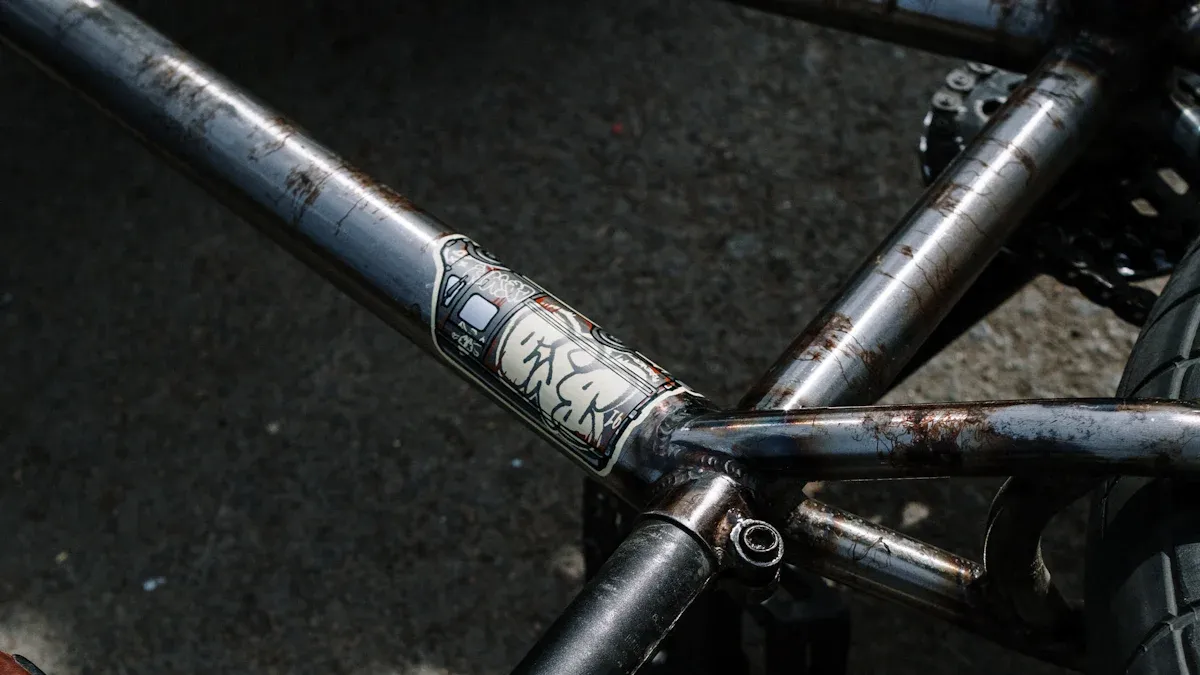
You want your steel bike frame to last, right? Start with regular cleaning. Wipe down your steel bike frames after rides, especially if you see dirt or moisture. Steel can develop rust if you ignore it, and corrosion often starts when you skip cleaning or let water sit. Most steel bike frame failures happen near welds, so check for cracks or odd bends. Quick attention to damage and a clean frame keep your steel bike frames strong for years.
Key Takeaways
Clean your steel bike frame often. Do this after wet or muddy rides. This helps stop rust. It also keeps your bike looking nice.
Lubricate moving parts and contact points a lot. Use the right grease for this. It helps stop rust. It makes your bike work well.
Check your bike frame for cracks and dents. Look for rust and paint damage too. This helps you find problems early. It keeps you safe.
Use rust inhibitors and protective coatings inside and outside. These block moisture. They help your bike last longer.
Store your bike in a dry place with air flow. Fix paint chips fast. This stops rust. It keeps your steel frame strong.
Steel Bike Frame Maintenance

Cleaning
Cleaning your steel bike frame helps it last longer. Dirt and water can make rust, so you should get rid of them fast. Experts say to clean off big dirt after every ride. This is extra important if you ride in rain or near salt. Cleaning often stops rust and keeps your bike looking nice.
Here is an easy way to clean your bike:
Spray your steel bike frame with water to wash off dirt.
Use a soft brush or sponge and warm soapy water. Bike cleaners like SILCA Ultimate Bike Wash are good and protect the frame’s finish.
Scrub the frame gently. Focus on joints and welds where dirt hides.
Clean the drivetrain with a brush and degreaser.
Rinse off all soap and dirt with clean water.
Dry the frame with a soft towel. Make sure no water stays on the frame, especially after wet rides.
Tip: Always dry your steel bike frame after you clean it. Water left on the frame can cause rust, even in hidden places.
You do not need strong chemicals. Some dish soaps can hurt metal parts. Use a bike cleaner made for steel bike frames. These are safe and easy to use. When you clean, look for paint chips or scratches. These spots can let water in and start rust.
Here is a table that shows what makes a good bike cleaner:
Feature | Benefit |
|---|---|
Easy to use and saves time | |
Safe on all surfaces | Works for steel, carbon, aluminum, and painted bikes |
Non-toxic and biodegradable | Good for you and the planet |
Superior rust inhibitors | Keeps metal parts safe from rust |
Effective cleaning agents | Cleans dirt without hard scrubbing |
Cleaning your bike often will keep your steel bike frame in great shape. Make it a habit and your bike will last longer.
Lubrication
Lubrication is just as important as cleaning your bike. It helps moving parts work well and stops rust. Pay close attention to the seatpost and where steel touches other metals.
Use ceramic or Teflon (PTFE) grease for most steel bike frame parts. These greases work well and stop parts from sticking. If your bike has an aluminum seatpost in a steel frame, use anti-seize or grease to stop rust.
How often should you add grease? It depends on where you ride. If you ride in rain, take out, clean, and grease the seatpost every two years. If you ride in dry places, you can wait up to five years. For steel seatposts in steel frames, check the grease every two months. Add new grease every five months, especially if your bike stays outside.
Here is a chart to help you remember:

Note: Always put grease on the seatpost and inside the seat tube before you put it together. This easy step can stop stuck parts and save money on repairs.
Greasing your bike often is a big part of steel bike frame care. It keeps your ride smooth and helps your bike last longer.
Inspection
Checking your bike helps you find problems early. Look over your steel bike frame every time you clean it. Pay close attention to welds and joints because they get the most stress.
Look for these signs:
Visible cracks: Check around welds, the head tube, bottom bracket, and seat tube cluster.
Dents or bends: These make the frame weak and can change how your bike rides.
Rust or corrosion: Watch for rust where paint is chipped or water sits.
Misalignment: Make sure wheels and parts line up straight.
Strange noises: Listen for creaks or clicks when you ride.
Soft spots: Press on the frame. If it feels soft or bends, something is wrong.
Loose components: If parts feel loose after tightening, check the frame.
Paint issues: Chips, bubbles, or wrinkles in paint can hide cracks.
Here is a table to help you spot problems:
Sign Type | Description | Location/Context |
|---|---|---|
Visible Cracks | Cracks or breaks, mostly around welds and stressed areas | Welds, head tube, bottom bracket, seat tube cluster, dropouts |
Dents or Bends | Dents make tubes weak; bends can make the bike ride badly | Frame tubes like downtube, top tube, seat stays, chain stays |
Corrosion/Rust | Rust makes steel frames weak and can cause cracks | Where paint is chipped or water collects |
Misalignment | Wheels or parts not straight, crooked or uneven pieces | Whole frame and wheel tracking |
Auditory Signs | Creaking, clicking, or popping sounds when riding | Frame area during pedaling or bumps |
Tactile Signs | Odd flexing, softness, or give when you push | Frame flex during hard turns or pedaling |
Handling Issues | Bike feels weird, hard to control, or loose | How the bike handles |
Component Fit Issues | Parts feel loose even when tight, hard to fit wheels or bearings | Handlebars, seatpost, wheel dropouts, bearing cups |
Paint Irregularities | Chips, flakes, bubbles, or wrinkles in paint that may mean cracks below | Over welds or stress points |
If you see any of these problems, fix them right away. Fixing things early can save your steel bike frame and keep you safe.
Cleaning, greasing, and checking your bike are the most important steps for steel bike frame care. Do these things often and you will have a smooth, safe ride for many years.
Rust Prevention
Keeping your steel bike frame free from rust takes a little effort, but it pays off with a bike that lasts for years. You can stop rust before it starts by using the right products, adding protective coatings, and storing your bike the smart way. Let’s break down how you can make rust prevention part of your regular routine.
Rust Inhibitors
Rust inhibitors are your first line of defense against corrosion inside your steel frame. These products work by creating a barrier that blocks water and air from reaching the metal. You want to use rust inhibitors like Frame Saver™ or Boeshield T-9™ inside your frame at least once every season. If you ride in the rain or store your bike for a long time, apply them more often.
Here’s a quick look at some of the most effective rust inhibitors for steel bike frames:
Rust Inhibitor | Effectiveness & Features | Limitations |
|---|---|---|
Xion Lab 2-in-1 Rust Converter & Metal Primer | Bonds with rust, no cracking after 90 days at high heat, water-based, easy to apply. | Needs brush or spray gun for best results. |
Boeshield T-9 | Developed for aircraft, forms a waxy film, cleans and protects, easy spray application. | Can be messy during use. |
LPS 3 | Lasts up to 2 years, self-healing, works in salty conditions, simple spray. | Sticky residue, strong smell. |
Zero Rust AR-62CA | Strong black coating, resists rust even if top coat fades, multiple ways to apply. | Needs clear coat for UV protection. |
NABAKEM #204 Peel-able Vinyl | Forms a tough film, easy to peel off, dries fast, great for tools and small parts. | Not for high heat, lower flash point. |
You should spray or brush these inhibitors inside the frame tubes. Make sure to follow the instructions on the product. For the best results, reapply at least twice a year, and always after wet rides or before storing your bike for weeks or months. Check the welds and joints every month for early signs of rust on bike frames. If you spot any, treat them right away.
Tip: Use rust-preventive sprays like WD-40 on moving parts and joints after wet rides. WD-40 pushes out water and gives short-term protection, but you’ll need to reapply it often. For longer-lasting results, choose products like LPS 3 or Boeshield T-9.
Protective Coatings
Protective coatings add another layer of defense to your steel bike frame. These coatings help prevent rust by sealing out moisture and air. Frame builders recommend using rust inhibitors like Frame Saver™ or Boeshield T-9™ inside the frame. For extra protection, some frames come with ED coating (a special paint applied inside the tubes), nickel plating, or zinc phosphate dipping. These methods work well for maintaining a rust-free bike frame.
You can also use oils and waxes such as boiled linseed oil, Fluid Film, or Woolwax inside the frame. These products coat the steel and keep out water. When you put your bike together, always grease the contact points. This step stops rust from forming where metal parts touch.
For the outside of your frame, try using polyurethane frame protectors, helicopter tape, or 3M Scotchgard. These films protect the paint from chips and scratches. They don’t prevent rust inside the frame, but they keep the surface looking good and stop water from reaching bare steel.
Note: If you see a paint chip or scratch, fix it right away. Touch up the paint or use a clear nail polish to seal the spot. This quick fix keeps water out and helps prevent rust.
Storage Tips
How you store your steel bike makes a big difference in rust prevention. Moisture is the enemy, so you want to keep your bike as dry as possible. Always store your bike indoors or under a roof. If you must keep it outside, use a high-quality, waterproof tarp and make sure air can flow underneath. This stops condensation from building up.
Here are some easy storage tips to prevent rust on bike frames:
Keep your bike in a dry, well-ventilated area.
Use moisture-absorbing materials or a dehumidifier if you live in a humid place.
Store your bike off the ground to avoid dampness.
Clean and dry your bike after every wet ride, paying attention to chains and gears.
Apply car-grade paste wax or rust inhibitors to create a moisture barrier.
Fix paint scratches right away to keep steel covered.
If you use a tarp, leave small holes for air to escape and prevent water buildup.
🚲 Pro Tip: Regular inspections and quick cleaning after wet rides go a long way in stopping corrosion before it starts.
By following these steps, you can prevent rust and keep your steel bike frame strong. Good habits with coatings, rust inhibitors, and smart storage will help your bike last for many years.
Rust Removal

Early Signs
You want to catch rust early before it spreads. The first signs usually show up where paint is chipped or scratched. Water collects in these spots and starts to eat away at the steel. Professional mechanics say you should check these areas during every inspection. If you see reddish-brown spots or rough patches, you have rust on bike frames. These weak spots can turn into cracks if you ignore them. Always look closely at welds, joints, and places where water might sit.
Tip: Shine a flashlight on the frame. Rust often hides in shadows or under cables.
Cleaning Methods
You can remove rust at home with simple tools for rust removal. Natural rust removers work well and are safe for steel. Here’s how you do it:
Grab white vinegar or lemon juice. Both break down rust fast.
Mix baking soda with water to make a thick paste.
Use a soft cloth or sponge to cover the rusty area with your chosen solution.
For tough rust, gently scrub with a wire brush or fine sandpaper. Don’t press too hard or you might damage the steel.
Wipe the area clean and dry it completely. Moisture causes more rust.
After cleaning, add a rust-resistant primer and finish with bike wax or oil. This keeps new rust from forming.
You don’t need fancy chemicals. These natural methods protect your steel bike frame and save you money.
Professional Help
Sometimes rust gets out of control. If you see deep rust or large patches, you should ask for professional help. Experts use bead blasting to remove rust and old paint from steel frames. This process costs between $75 and $150 for a bike frame. Bead blasting cleans the metal and gives it a rough surface so powder coating sticks better. Powder coating makes your frame tough and weatherproof.
Here’s a quick look at typical costs:
Item Size | Typical Cost Range |
|---|---|
Small parts | $25 – $50 each |
Bike frames | $75 – $150 |
Large projects | $150 – $300 |
After bead blasting, the shop will prime your frame right away. If you do it yourself, degrease the steel with acetone or alcohol, treat the rust spots, and apply primer the same day. This stops new rust from forming. You can leave frame holes open or seal them with silicone, but always keep the bottom bracket open.
🚲 Pro Tip: If you don’t have the time or tools for rust removal, let a pro handle it. You’ll get a strong, good-looking steel bike frame that lasts.
Polishing and Paint Chips
Polishing
You want your steel bike frame to look shiny and stay protected. Polishing does both. Start by washing your steel frame with soap and water. Dry it well. If you see any rust spots, use steel wool to scrub them away. For stubborn spots, add a drop of polishing compound. After that, dust off the frame with a soft brush.
Here’s a simple way to polish your steel bike frame:
Put a small amount of polishing compound on a clean cloth.
Rub the compound onto the frame using small, circular motions.
Focus on scuffs and scratches to bring back the shine.
Wipe off any extra polish with another clean cloth.
Repeat if you want an even brighter finish.
For extra protection, you can use clearcoating products like Everbrite or automotive clearcoats. Powder coating works well if you want a tough finish, especially in wet places. Just avoid lacquers that trap moisture, since they can cause rust.
Tip: Always keep your bike dry and covered when you’re not riding. This helps keep your steel frame looking great.
Paint Repair
Paint chips can let water reach the steel and start rust. Fixing them quickly is key. First, check the damage. If your bike has been in a crash, you might want a pro to look for deeper problems.
To repair paint chips:
Match the paint color using a chart or ask your bike’s maker.
Get enamel-based paint or a touch-up kit.
Clean the chipped area with detergent, dry it, then wipe with isopropyl alcohol.
Use a small brush to apply thin layers of paint. Let each layer dry before adding the next.
When the paint is thick enough, gently sand it with fine emery paper to blend it in.
For bigger repairs, finish with wax or a clear coat for extra shine and protection.
If you spot a chip, fix it soon. This stops rust from getting a foothold.
Preventing Future Rust
After polishing and paint repair, you want to keep your steel bike frame safe. Preventing future rust is all about good habits. Clean your bike often to remove dirt and moisture. Apply wax or oil to the frame to create a barrier against water. Store your bike indoors or use a cover to keep out rain and humidity.
Here are some easy steps for preventing future rust:
Fix scratches and paint chips right away.
Keep moving parts, like the chain and gears, well lubricated.
Use rust inhibitors inside the frame every season, especially if you ride in wet or salty places.
Grease all contact points during assembly, including bolts and threads.
After wet rides, remove the seat post and store the bike upside down overnight to let moisture escape.
🚲 Regular care and quick repairs make a big difference in preventing future rust and keeping your steel bike frame strong.
Taking care of your steel bike frame is simple if you stick to the basics.
Inspect your frame often for cracks and rust, especially at joints and welds.
Clean and dry your bike after every ride.
Fix paint chips and use rust inhibitors to keep rust away.
Store your bike in a dry place and check protection regularly.
Regular care keeps your bike strong, looking great, and even helps its resale value. Make these habits part of your routine and your steel bike will ride with you for years! 🚲
FAQ
How often should you clean your steel bike frame?
You should clean your steel bike frame after every muddy or wet ride. For dry rides, once a week works well. Quick wipe-downs help stop rust and keep your bike looking sharp.
What should you do if you find a small rust spot?
Don’t panic!
Wipe the area dry. Use a little vinegar or baking soda paste to scrub the rust. Dry it again. Cover the spot with touch-up paint or clear nail polish to seal it.
Can you use WD-40 on your steel bike frame?
Yes, you can use WD-40 to push out water and protect against rust. Spray it on joints and moving parts after wet rides. Remember, WD-40 is not a long-term lubricant, so use bike grease for lasting protection.
Is it okay to store your steel bike outside?
You can store your bike outside, but it’s not the best choice. If you must, use a waterproof cover and keep the bike off the ground. Check for moisture often. Indoor storage keeps your steel frame safer from rust.
See Also
Top Bike Frame Protection Strategies All Cyclists Must Learn
Factors That Determine Steel Mountain Bike Frame Quality
A Buyer’s Guide To Carbon Aluminum And Steel Bike Frames
How Single Gear Bike Frames Evolved From Iron To Carbon
Advantages And Disadvantages Of Aluminum Bike Frame Strength
